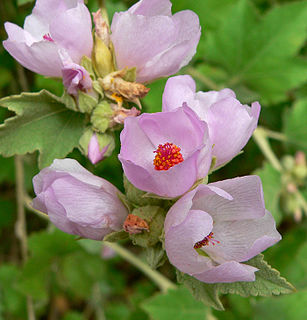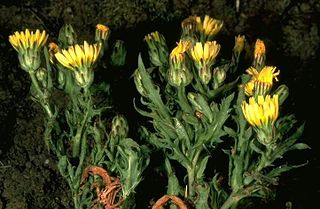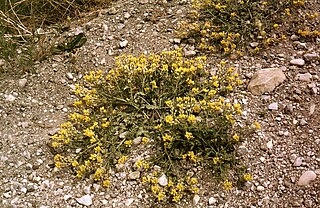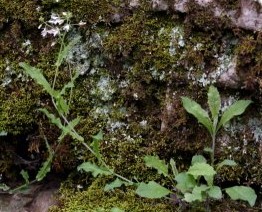Sibara is a genus of ten plant species in the mustard family known commonly as the winged rockcresses. They are native to North America. Sibara are similar to cardamines, sending up thin herbaceous stems that bear tiny white to purple flowers. Seeds are borne in flat, laterally compressed, fleshy fruits up to an inch long. Selected species:

Lasthenia burkei is a rare species of flowering plant in the daisy family known by the common names Burke's goldfields and Burke's baeria.

Galium buxifolium is a rare species of flowering plant in the coffee family known by the common names box bedstraw and island bedstraw. It is endemic to the Channel Islands of California, where it is known from about 26 populations on two of the islands. It is a federally listed endangered species of the United States.

Boechera hoffmannii is a rare species of flowering plant in the mustard family known by the common name Hoffmann's rockcress. It is endemic to the Channel Islands of California, where it is known from only three or four populations on two of the eight islands. A 2005 report estimated a remaining global population of 244 individual plants. It is a federally listed endangered species.

Arabis macdonaldiana is a species of flowering plant in the mustard family known by the common name MacDonald's rockcress. It is native to northern California and Oregon, where it grows on newly exposed, barren serpentine soils in openings in temperate coniferous forest habitat. It is a rare and endangered plant known from several sites in California and approximately two occurrences in Oregon, where it is threatened mainly by mining, particularly of nickel, which is one of several metals plentiful in the serpentine. On September 29, 1978, this was the second plant to be federally listed as an endangered species.

Malacothamnus clementinus is a rare species of flowering plant in the mallow family known by the common name San Clemente Island bushmallow. It is endemic to San Clemente Island, one of the Channel Islands of California, where it is known from fewer than ten occurrences in the steep, rocky seaside canyons. The plant became a federally listed endangered species in 1977 when it was limited to a single population nearing extinction due to herbivory by the feral goats which once infested the small island. The goats have since been removed and the plant is recovering well, but many threats still remain, including competition with introduced species of plants, wildfire, erosion, and damage to the landscape by United States Navy bombing exercises. Since the Navy removed goats from the island in the 1990s and started an intensive management program this species has recovered significantly. There are now over 80 known populations on the island consisting of over 1,500 individuals. In the last review of this species, the United States Fish and Wildlife Service recommended downlisting this species due to its recovery and the ongoing management that the Navy has committed to. This is a bushy shrub with a thin, multibranched stem coated in long, fine hairs. It reaches heights between 40 centimeters and one meter. It bears rounded dark green leaves several centimeters long which are divided into sharp lobes. The inflorescence is a spikelike cluster of a few pale pink, lavender, or nearly white flowers with somewhat lance-shaped, hairy petals several millimeters long. It rarely produces fertile seed and it is believed to propagate itself mainly via rhizomes.

Malacothamnus fasciculatus, with the common names chaparral mallow and Mendocino bushmallow, is a species of flowering plant in the mallow family. It is found in far western North America.
Malacothrix indecora is a rare species of flowering plant in the aster family known by the common name Santa Cruz Island desertdandelion. It is endemic to the Channel Islands of California, where it is known from only a few populations on three of the eight islands. As of 2000, there were three occurrences on San Miguel Island, two on Santa Rosa Island, and one on Santa Cruz Island. It grows on the bluffs and rocky coastal grasslands of the islands. Like many Channel Islands endemics, this plant is naturally limited in distribution and has been threatened by the presence of destructive introduced mammals, in this case, feral pigs. The plant became a federally listed endangered species in 1997. This is a mat-forming annual herb which spreads low to the ground no more than about 10 centimeters high. The fleshy leaves have dull lobes. The inflorescence is an array of flower heads lined with oval-shaped phyllaries. The ray florets are under a centimeter long and yellow in color.

Malacothrix squalida is a rare species of flowering plant in the aster family known by the common name Santa Cruz desertdandelion. It is endemic to Santa Cruz and Anacapa Islands, two of the eight Channel Islands of California, where it grows on rocky seaside bluffs and cliffs. The plant is very limited in distribution and today exists only in degraded habitat on these two small islands. It was last collected from Santa Cruz Island in 1968, and two populations were noted on Anacapa Island in 1998; in drought years there may be no plants at all. It became a federally listed endangered species in 1997. This is an annual herb growing a hairless, waxy stem 20 to 30 centimeters in maximum height. The leaves are sharply lobed. The inflorescence is an array of flower heads lined with oval-shaped phyllaries. The ray florets are 1 to 2 centimeters and light yellow in color.
Sedella leiocarpa is a rare species of flowering plant in the stonecrop family known by the common names Lake County mock stonecrop and Lake County stonecrop. It is endemic to Lake County, California, where it is known from only about ten occurrences in two locations. It is a resident of drying vernal pools and rocky clay flats, where it grows in colonies. It is a federally listed endangered species. This is an annual herb growing no more than four centimeters high. It is a tiny erect reddish or yellow succulent plant with sparse leaves each a few millimeters long. The flowers have yellow to reddish petals 3 or 4 millimeters long.

Phacelia insularis, the coast phacelia is a rare species of phacelia. It is endemic to California, where it has a disjunct distribution.
Pseudobahia bahiifolia is a rare species of flowering plant in the aster family known by the common name Hartweg's golden sunburst.

Rorippa columbiae is a species of flowering plant in the mustard family known by the common names Columbian yellowcress and Columbia yellow cress.
Sibara virginica is a species of flowering plant in the mustard family known by the common name Virginia winged rockcress. It is native to North America, where it can be found throughout the southeastern quadrant of the United States and in California and Baja California in the west. It grows in many types of habitat, including disturbed areas. It is an annual or biennial herb producing a basal rosette of leaves with comblike blades so deeply divided into many lobes that they may appear to have leaflets. It bolts one or more erect stems up to 30 centimeters tall. The flowers each have four spoon-shaped white petals a few millimeters long and purplish sepals. The fruit is a flattened, elongated silique up to 2.5 centimeters long containing tiny seeds.

Thysanocarpus conchuliferus is a rare species of flowering plant in the mustard family known by the common name Santa Cruz Island fringepod. It is endemic to Santa Cruz Island, one of the Channel Islands of California, where has been recently observed at only one location; some years it is totally absent.

Boechera perstellata is a rare species of flowering plant in the mustard family known by the common names Braun's rockcress and Nevada rockcress. It is native to Kentucky and Tennessee, where it is known from perhaps 25 total populations. Most of the occurrences have few individuals, and all are deteriorating in quality. The plant grows in shady forest habitat on limestone substrates, usually near streams or rivers. This is a federally listed endangered species of the United States.

Arabis serotina is a rare species of flowering plant in the mustard family known by the common name shale barren rockcress. It is native to eastern West Virginia and western Virginia in and around the Shenandoah Valley, where it is known from fewer than 60 populations. It is endemic to the shale barrens, a type of habitat characterized by steep slopes of bare shale, an exposed, rocky habitat type that is subject to very dry and hot conditions. Shale barrens host a number of endemics, such as Allium oxyphilum and Taenidia montana, and this rockcress is among the rarest. It is a federally listed endangered species.
Euphorbia eleanoriae is a rare species of flowering plant in the euphorb family known by the common name Nā Pali sandmat. It is endemic to Kauaʻi, Hawaii. Like other native Hawaiian euphorbs it is called ʻakoko locally. This plant was only discovered in 1992 and described to science in 1996 as Chamaesyce eleanoriae. At that time there were fewer than 500 plants known, all occurring in small populations scattered across the sheer cliffs along the Nā Pali Coast of Kauaʻi. By 2001 the total population had already dropped; only three populations were found, for a total of fewer than 50 plants. The plant was federally listed as an endangered species of the United States in 2010.

Hypericum cumulicola is a rare species of flowering plant in the St. John's wort genus known by the common name highlands scrub hypericum, or highlands scrub St. John's wort. It is endemic to Florida, where it is threatened by habitat loss and degradation. It is a federally listed endangered species of the United States.
Lysimachia pendens is a rare species of flowering plant in the family Primulaceae known by the common name broad-leaf yellow loosestrife. It is endemic to Hawaii, where there is a single occurrence known on the island of Kauai. It was federally listed as an endangered species of the United States in 2010.






















